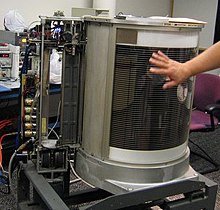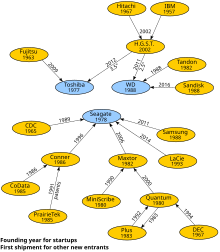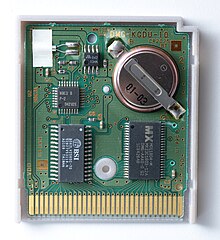History of hard disk drives
In 1953 IBM recognized the immediate application for what it termed a "Random Access File" having high capacity and rapid random access at a relatively low cost.[1] After considering technologies such as wire matrices, rod arrays, drums, drum arrays, etc.,[1] the engineers at IBM's San Jose California laboratory invented the hard disk drive.[2] The disk drive created a new level in the computer data hierarchy, then termed Random Access Storage but today known as secondary storage, less expensive and slower than main memory (then typically drums) but faster and more expensive than tape drives.[3]
The commercial usage of hard disk drives began in 1956 with the shipment of an IBM 305 RAMAC system including IBM Model 350 disk storage.[4] US Patent 3,503,060issued March 24, 1970, and arising from the IBM RAMAC program is generally considered to be the fundamental patent for disk drives.[5]
Each generation of disk drives replaced larger, more sensitive and more cumbersome devices. The earliest drives were usable only in the protected environment of a data center. Later generations progressively reached factories, offices and homes, eventually reaching ubiquity.
Disk media diameter was nominally 8 or 14 inches (200 or 360 mm) and were typically mounted in standalone boxes (resembling washing machines) or large equipment rack enclosures. Individual drives often required high-current AC power due to the large motors required to spin the large disks. Hard disk drives were not commonly used with microcomputers until after 1980, when Seagate Technology introduced the ST-506, the first 5.25 inches (133 mm) drive.
The capacity of hard drives has grown exponentially over time. When hard drives became available for personal computers, they offered 5-megabyte capacity. During the mid-1990s the typical hard disk drive for a PC had a capacity of about 1 gigabyte.[6] As of December 2014, desktop hard disk drives typically had a capacity of 500 to 4000 gigabytes, while the largest-capacity drives were 8 terabytes.
Contents
[hide]
[hide]
1950s–1970s
Main article: Early IBM disk storage
The IBM 350 Disk File, invented by Reynold Johnson, was introduced in 1956 with the IBM 305 RAMAC computer. This drive had fifty 24 inches (0.61 m) platters, with a total capacity of five million 6-bit characters (3.75 megabytes).[7] A single head assembly having two heads was used for access to all the platters, yielding an average access time of just under 1 second.
The IBM 1301 Disk Storage Unit,[8] announced in 1961, introduced the usage of heads having self-acting air bearings (self-flying heads) with one head per each surface of the disks.
Also in 1961, Bryant Computer Products introduced its 4000 series disk drives. These massive units stood 52 inches (1.3 m) tall, 70 inches (1.8 m) wide, and had up to 26 platters, each 39 inches (0.99 m) in diameter, rotating at up to 1,200 rpm. Access times were from 50 to 205 milliseconds (ms). The drive's total capacity, depending on the number of platters installed, was up to 205,377,600 bytes (205 MB).[9][10]
The first disk drive to use removable media was the IBM 1311 drive. It was introduced in 1962 using the IBM 1316 disk pack to store two million characters. It was followed by the IBM 2311 (1964) 5 megabyte and IBM 2314 (1965) 29 megabyte disk pack HDDs.
Memorex in 1968 shipped the first HDD, the Memorex 630, plug compatible to an IBM model 2311 marking the beginning of independent competition (Plug Compatible Manufacturers or PCMs) for HDDs attached to IBM systems. It was followed in 1969 by the Memorex 660, an IBM 2314 compatible, which was OEM'ed to DEC and resold as the RP02.
In 1973, IBM introduced the IBM 3340 "Winchester" disk drive, the first significant commercial use of low mass and low load heads with lubricated platters. This technology and its derivatives remained the standard through 2011. Project head Kenneth Haughton named it after the Winchester 30-30 rifle because it was planned to have two 30 MB spindles; however, the actual product shipped with two spindles for data modules of either 35 MB or 70 MB.[11] The name 'Winchester' and some derivatives are still common in some non-English speaking countries to generally refer to any hard disks (e.g. Hungary, Russia).
Also in 1973, Control Data Corporation introduced the first of its series of SMD disk drives using conventional disk pack technology. The SMD family became the predominant disk drive in the minicomputer market into the 1980s.
During the 1970s, captive production, dominated by IBM's production for its own use, remained the largest revenue channel for HDDs, though the relative importance of the OEM channel grew. Led by Control Data, Diablo Systems, CalComp and Memorex, the OEMsegment reached $631 million in 1979, but still well below the $2.8 billion associated with captive production.[12]
1980s, the PC era
As the 1980s began, hard disk drives were a rare and very expensive optional feature on personal computers (PCs); however by the late '80s, hard disk drives were standard on all but the cheapest PC.
Most hard disk drives in the early 1980s were sold to PC end users by systems integrators such as the Corvus Disk System or the systems manufacturer such as the Apple ProFile. The IBM PC XT in 1983 included an internal standard 10MB hard disk drive, and soon thereafter internal hard disk drives proliferated on personal computers.
Timeline
- 1956 – IBM 350, first commercial disk drive, 5 million characters (6-bit).
- 1961 – IBM 1301 Disk Storage Unit introduced with one head per surface and aerodynamic flying heads, 28 million characters (6-bit) per module.
- 1961 – Bryant Computer Products division of Ex-Cell-O, 1 meter platters, 1200 RPM, up to 205MB.
- 1962 – IBM 1311 introduced removable disk packs containing 6 disks, storing 2 million characters per pack
- 1964 – IBM 2311 with 7.25 megabytes per disk pack
- 1964 – IBM 2310 removable cartridge disk drive with 1.02 MB on one disk
- 1965 – IBM 2314 with 11 disks and 29 MB per disk pack
- 1968 – Memorex is first to ship an IBM-plug-compatible disk drive
- 1970 – IBM 3330 Merlin, introduced error correction, 100 MB per disk pack
- 1973 – IBM 3340 Winchester introduced removable sealed disk packs that included head and arm assembly, 35 or 70 MB per pack
- 1973 – CDC SMD announced and shipped, 40 MB disk pack
- 1976 – 1976 IBM 3350 "Madrid" – 317.5 Megabytes, eight 14" disks, Re-introduction of disk drive with fixed disk media
- 1979 – IBM 3370 introduced thin film heads, 571 MB, non-removable
- 1979 – 1979 IBM 62PC "Piccolo" – 64.5 Megabytes, six 8" disks, First 8-inch HDD
- 1980 – The IBM 3380 was the world's first gigabyte-capacity disk drive. Two 1.26 GB, head disk assemblies (essentially two HDDs) were packaged in a cabinet the size of a refrigerator,[13] weighed 249 kg, and had a price tag of 40,000 USD which is 114,491 USD in present day terms.[14]
- 1980 – ST-506 first 51⁄4 inch drive released with capacity of 5 megabytes, cost 1500 USD
- 1983 – RO351/RO352 first 31⁄2 inch drive released with capacity of 10 megabytes [15]
- 1986 – Standardization of SCSI
- 1988 – PrairieTek 220 – 20 Megabytes, two 2.5" disks, First 2.5 inch HDD.
- 1989 – Jimmy Zhu and H. Neal Bertram from UCSD proposed exchange decoupled granular microstructure for thin film disk storage media, still used today.
- 1990 – 1990 IBM 0681 "Redwing" – 857 Megabytes, twelve 5.25" disks. First HDD with PRML Technology (Digital Read Channel with 'partial response maximum likelihood' algorithm)
- 1991 – IBM 0663 "Corsair" – 1,004 Megabytes, eight 3.5" disks; first HDD using magnetoresistive heads
- 1991 – Integral Peripherals 1820 "Mustang" – 21.4 Megabytes, one 1.8" disk, first 1.8 inch HDD[16]
- 1992 – HP Kittyhawk first 1.3-inch hard-disk drive –
- 1993 – IBM 3390 model 9, the last Single Large Expensive Disk drive announced by IBM
- 1994 – IBM introduces Laser Textured Landing Zones (LZT)
- 1997 – IBM Deskstar 16GP "Titan" – 16,800 Megabytes, five 3.5" disks; first (Giant Magnetoresistance) heads
- 1997 – Seagate introduces the first hard drive with fluid bearings[17]
- 1998 – UltraDMA/33 and ATAPI standardized
- 1999 – IBM releases the Microdrive in 170 MB and 340 MB capacities
- 2002 – 137 GB addressing space barrier broken
- 2003 – Serial ATA introduced
- 2003 – IBM sells disk drive division to Hitachi
- 2004 – MK2001MTN first 0.85 inch drive released by Toshiba with capacity of 2 gigabytes[16]
- 2005 – First 500 GB hard drive shipping (Hitachi GST)
- 2005 – Serial ATA 3Gbit/s standardized
- 2005 – Seagate introduces Tunnel MagnetoResistive Read Sensor (TMR) and Thermal Spacing Control
- 2005 – Introduction of faster SAS (Serial Attached SCSI)
- 2005 – First perpendicular magnetic recording (PMR) HDD shipped: Toshiba 1.8-inch 40/80 GB[18]
- 2006 – First 750 GB hard drive (Seagate)
- 2006 – First 200 GB 2.5" hard drive utilizing perpendicular recording (Toshiba)
- 2006 – Fujitsu develops heat-assisted magnetic recording (HAMR) that could one day achieve one terabit per square inch densities.[19]
- 2007 – First 1 terabyte[20] hard drive[21] (Hitachi GST)
- 2008 – First 1.5 terabyte[20] hard drive[22] (Seagate)
- 2009 – First 2.0 terabyte hard drive[23] (Western Digital)
- 2010 – First 3.0 terabyte hard drive[24][25] (Seagate, Western Digital)
- 2010 – First Hard Drive Manufactured by using the Advanced Format of 4,096 bytes a block ("4K") instead of 512 bytes a block[26]
- 2011 – First 4.0 terabyte hard drive[27] (Seagate)
- 2011 - Floods hit many hard drive factories. Predictions of a worldwide shortage of hard disk drives cause prices to double.[28][29][30]
- 2012 – Western Digital announces the first 2.5-inch, 5mm thick drive, and the first 2.5-inch, 7mm thick drive with two platters.[31] (Western Digital)
- 2012 – HGST announces helium-filled hard disk drives, promising cooler operation and the ability to increase the maximum number of platters from five to seven in the 3.5" form factor.[32] (Hitachi GST)
- 2012 – TDK demonstrates 2 TB on a single 3.5-inch platter [33]
- 2012 – Toshiba re-enters the 3.5" desktop hard disk drive market with capacities up to 3 TB.[34] This is made possible by the U.S. Federal Trade Commission demanding that Western Digital and Hitachi GST give assets and intellectual property rights to Toshiba.[35] Prior to this, Toshiba had only manufactured 2.5" laptop HDDs for many years.
- 2013 – Seagate announces that it will ship hard disk drives with capacities up to 5 TB using shingled magnetic recording (SMR), a method where tracks are written to partially overlap each other. The read head, being smaller, can still read the overlapped tracks.[36]
- 2013 – HGST announces a helium-filled 6 TB hard disk drive for enterprise applications.[37]
- 2013 – Western Digital demonstrates heat assisted magnetic recording (HAMR) technology.[38][39][40][41]
- 2014 – Seagate introduces 6 TB hard drives that do not use helium, in turn increasing their power consumption and lowering their overall cost.[42]
- 2014 – Seagate ships worlds first 8 TB hard drives.[43]
- 2014 - Western Digital's HGST subsidiary sampling 10 TB hard drives filled with helium.[44]
Manufacturing history
As of December 2011, virtually all of the world's HDDs were manufactured by three large companies: Seagate,[45] Western Digital, andToshiba. Hitachi (HGST) was acquired by Western Digital in 2012.[46]
The market has continued to consolidate since the 1980s as dozens of manufacturers exited or were acquired. The first notable casualty in the PC era was Computer Memories Inc. or CMI; after an incident with faulty 20MB AT disks in 1985,[47] CMI's reputation never recovered, and they exited the HDD business in 1987. Another notable failure was MiniScribe, which went bankrupt in 1990 after it was found that they had engaged in accounting fraud and inflated sales numbers for several years. Many other companies (like Kalok,Microscience, LaPine, Areal, Priam, and PrairieTek) also did not survive the shakeout, and had disappeared by 1993; Micropolis was able to hold on until 1997, and JTS, a relative latecomer, lasted only a few years and was gone by 1999, after attempting to manufacture in India. JTS originated a 3″ form factor for use in laptop computers. Quantum and Integral also invested in the 3″ form factor; but the form factor failed to catch on. Rodime was an important manufacturer during the 1980s, but stopped making disks in the early 1990s to concentrate on technology licensing; they hold a number of patents related to 3.5-inch form factor HDDs.
The following is the genealogy of the remaining participants:
- 1967: Hitachi enters the HDD business.
- 1967: Toshiba enters the HDD business.
- 1979: Seagate Technology[48] founded.
- 1988: Western Digital, then a well-known controller designer, enters the HDD business by acquiring Tandon Corporation's disk manufacturing division.[49]
- 1988: Samsung enters the worldwide HDD market, previously having manufactured Comport disk drives for the Korean market.[50]
- 1989: Seagate purchases Control Data's HDD business.
- 1990: Maxtor purchases MiniScribe out of bankruptcy, making it the core of its low-end HDDs.
- 1994: Quantum purchases DEC's storage division, giving it a high-end disk range to go with its more consumer-oriented ProDriverange.
- 1996: Seagate acquires Conner Peripherals in a merger.
- 2000: Maxtor acquires Quantum's HDD business; Quantum remains in the tape business.
- 2003: Hitachi acquires the majority of IBM's disk division, renaming it Hitachi Global Storage Technologies (HGST).
- 2006: Seagate acquires Maxtor.
- 2009: Toshiba acquires Fujitsu's HDD division.[51]
- 2011: Western Digital proposes acquiring Hitachi's HDD division.[46]
- 2011: Seagate acquires Samsung's HDD division.[45]
- 2012: Western Digital acquires Hitachi Global Storage Technologies.[46]
- 2012: Seagate acquires Lacie.[52]
In 2011, based on market research firm IDC, the biggest hard drive makers were Seagate Technology and Western Digital Corp., but the largest national producer was China, followed by Thailand which makes about a quarter of the world's hard drives. The concentration of hard disk drive producers in only a few countries made the supply vulnerable to disruptions like the 2011 Thailand floods.[53]
HARD DISK DRIVE GUIDE
A Brief History of the Hard Disk Drive
The hard disk drive has short and fascinating history. In 24 years it evolved from a monstrosity with fifty two-foot diameter disks holding five MBytes (5,000,000 bytes) of data to today's drives measuring 3 /12 inches wide and an inch high (and smaller) holding 400 GBytes (400,000,000,000 bytes/characters). Here, then, is the short history of this marvelous device.
Before the disk drive there were drums... In 1950 Engineering Research Associates of Minneapolis built the first commercial magnetic drum storage unit for the U.S. Navy, the ERA 110. It could store one million bits of data and retrieve a word in 5 thousandths of a second.
By 1961 IBM had invented the first disk drive with air bearing heads and in 1963 they introduced the removable disk pack drive.
In 1970 the eight inch floppy disk drive was introduced by IBM. My first floppy drives were made by Shugart who was one of the "dirty dozen" who left IBM to start their own companies. In 1981 two Shugart 8 inch floppy drives with enclosure and power supply cost me about $350.00. They were for my second computer. My first computer had no drives at all.
In 1973 IBM shipped the model 3340 Winchester sealed hard disk drive, the predecessor of all current hard disk drives. The 3340 had two spindles each with a capacity of 30 MBytes, and the term "30/30 Winchester" was thus coined.
| Seagate ST4053 40 MByte 5 1/4 inch, full-height "clunker" with ST506 interface and voice coil circa 1987. My cost was $435.00. |
In 1980, Seagate Technology introduced the first hard disk drive for microcomputers, the ST506. It was a full height (twice as high as most current 5 1/4" drives) 5 1/4" drive, with a stepper motor, and held 5 Mbytes. My first hard disk drive was an ST506. I cannot remember exactly how much it cost, but it plus its enclosure, etc. was well over a thousand dollars. It took me three years to fill the drive. Also, in 1980 Phillips introduced the first optical laser drive. In the early 80's, the first 5 1/4" hard disks with voice coil actuators (more on this later) started shipping in volume, but stepper motor drives continued in production into the early 1990's. In 1981, Sony shipped the first 3 1/2" floppy drives.
In 1983 Rodime made the first 3.5 inch rigid disk drive. The first CD-ROM drives were shipped in 1984, and "Grolier's Electronic Encyclopedia," followed in 1985. The 3 1/2" IDE drive started its existence as a drive on a plug-in expansion board, or "hard card." The hard card included the drive on the controller which, in turn, evolved into Integrated Device Electronics (IDE) hard disk drive, where the controller became incorporated into the printed circuit on the bottom of the hard disk drive. Quantum made the first hard card in 1985.
In 1986 the first 3 /12" hard disks with voice coil actuators were introduced by Conner in volume, but half (1.6") and full height 5 1/4" drives persisted for several years. In 1988 Conner introduced the first one inch high 3 1/2" hard disk drives. In the same year PrairieTek shipped the first 2 1/2" hard disks.
- 1994 DMA, Mode 2 at 16.6 MB/s
- 1997 Ultra ATA/33 at 33.3 MB/s
- 1999 Ultra ATA/66 at 66.6 MB/s









